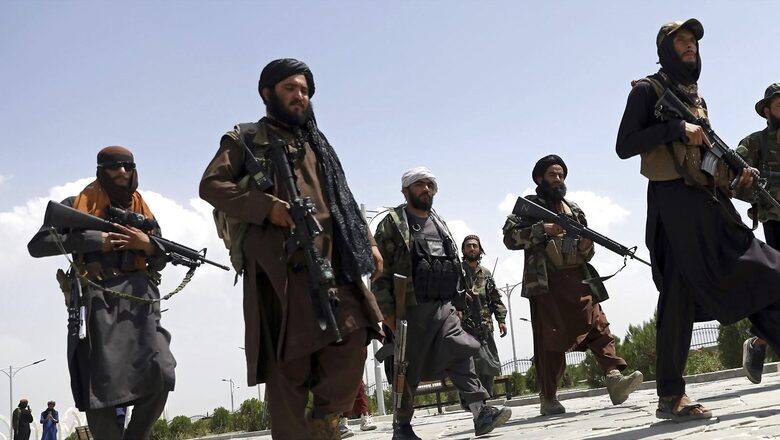
views
As the United States completed its military retreat from Afghanistan on August 31 after the 20-year-long American deployment in the war-torn country, some of the Taliban’s top leaders in Kabul have initiated talks on setting up a new government in Afghanistan.
It is being reported that hectic negotiations are underway between Taliban leadership and the Haqqani Network over the formation of government in Afghanistan. Sources told CNN-News18 that the insurgents are designing a government based on Iran’s model – an Islamic republic where the Supreme Leader is the head of state and the highest-ranking political and religious authority even above the president.
Taliban’s supreme leader Hibatullah Akhundzada — who has never made a public appearance and whose whereabouts have largely remained unknown – will most likely be the Supreme Leader, presiding over a Supreme Council of 11 to 72, sources added. The Supreme Leader will mostly work out of Kandahar.
The reports of differences between Mullah Yaqoob and the Haqqani factions are doing rounds even though the Taliban leadership is trying to project a united front to the world. It is believed that Yaqoob, son of first Emir-ul-Momeen Mullha Omar, wants to bring military elements into the new Afghan cabinet instead of political factors being pushed by Mullah Barader, the co-founder of the Sunni Islamist group.
According to Hindustan Times, reports from capital city Kabul indicate that Yaqoob has clearly said that those living in luxury of Doha cannot dictate terms to those involved in askari jihad against the US led occupation forces. Mullah Barader and Sher Mohammed Stanekzai handled the political office of Taliban from Doha and negotiated with US ambassador Zalmay Khalilzad with Pakistan and the UK leaders involved in the exercise.
The Haqqani Network controls Kabul, while Mullah Yaqoob is holding the Kandahar. Now concerns have emerged that the Taliban government may have a pro-Afghan faction of Kandaharis and pro-Pak faction of Haqqanis in the country.
These are the key players in the current Taliban:
Hibatullah Akhundzada, the supreme leader
Hibatullah Akhundzada was appointed leader of the Taliban in a swift power transition after a 2016 US drone strike killed his predecessor, Mullah Akhtar Mansour.
Before ascending the movement’s ranks, Akhundzada was a low-profile religious figure. He is widely believed to have been selected to serve more as a spiritual figurehead than a military commander.
After being appointed leader, Akhundzada secured a pledge of loyalty from Al-Qaeda chief Ayman al-Zawahiri, who showered the cleric with praise — calling him “the emir of the faithful”.
This helped seal his jihadi credentials with the group’s long-time allies.
Akhundzada was tasked with the enormous challenge of unifying a militant movement that briefly fractured during the bitter power struggle after Akhtar’s assassination, and the revelation that the leadership had hidden the death of Taliban founder Mullah Omar for years.
His public profile has largely been limited to the release of messages during Islamic holidays, but the group has shed some light on his whereabouts following its takeover of Afghanistan.
“He is present in Kandahar,” Taliban spokesman Zabihullah Mujahid said.
Another spokesman said Akhundzada is due to make a public appearance “soon”.
Mullah Baradar, the co-founder
Abdul Ghani Baradar was raised in Kandahar — the birthplace of the Taliban movement.
Like most Afghans, Baradar’s life was forever altered by the Soviet invasion of the country in the late 1970s, transforming him into an insurgent.
He was believed to have fought side-by-side with the one-eyed cleric Mullah Omar.
The two would go on to found the Taliban movement in the early 1990s during the chaos and corruption of the civil war that followed the Soviet withdrawal.
After the Taliban regime was toppled in 2001 by US-led forces, Baradar is believed to have been among a small group of insurgents who approached interim leader Hamid Karzai with a potential deal that would have seen the militants recognise the new administration.
Arrested in Pakistan in 2010, Baradar was kept in custody until pressure from the United States saw him freed in 2018 and relocated to Qatar.
This is where he was appointed head of the Taliban’s political office and oversaw the signing of the troop withdrawal agreement with the United States.
Sirajuddin Haqqani, the Haqqani network
The son of a famed commander from the anti-Soviet jihad, Sirajuddin Haqqani doubles as the deputy leader of the Taliban and head of the powerful Haqqani network.
The Haqqani network is a US-designated terror group long viewed as one of the most dangerous militant factions in Afghanistan.
It is infamous for its use of suicide bombers and is believed to have orchestrated some of the most high-profile attacks in Kabul over the years.
The network is also accused of assassinating top Afghan officials and holding kidnapped Western citizens for ransom — including US soldier Bowe Bergdahl, released in 2014.
Known for their independence, fighting acumen, and savvy business dealings, the Haqqanis are mainly based in eastern Afghanistan and hold considerable sway over the Taliban’s leadership council.
The Haqqani network is blamed for some of the deadliest and most shocking attacks in Afghanistan during the last two decades.
What is the role of Haqqani in the new Taliban regime?
The Haqqanis have emerged as serious players in the Taliban’s political project with at least two of their leaders in Kabul as talks begin on forming the next government.
Sirajuddin Haqqani’s formal elevation to the deputy leader position six years ago cemented that role, analysts say.
And the release of his brother Anas from Afghan custody in 2019 was seen as a move to help kickstart the direct US-Taliban talks that eventually led to the troop withdrawal.
Sirajuddin Haqqani even wrote an op-ed in The New York Times last year, outlining the Taliban’s position on the US talks and the conflict in Afghanistan — though in diplomatic tones that belied the network’s violent reputation.
While Anas Haqqani has held talks with Karzai, his uncle Khalil Haqqani was seen leading prayers in Kabul on Friday.
Sirajuddin and Khalil are both still listed as wanted by the United States, with millions of dollars in bounties on offer.
Mullah Yaqoob, the scion
The son of Taliban co-founder Mullah Omar, Mullah Yaqoob heads the group’s powerful military commission, which oversaw the vast network of field commanders charged with executing the insurgency.
Yaqoob’s father enjoyed cult-like status as the Taliban leader, and that potent lineage makes him a unifying figure in the movement.
Speculation remains, however, about Yaqoob’s exact role — with some analysts arguing that his appointment in 2020 was merely cosmetic.
(with inputs from AFP)
Read all the Latest News, Breaking News and Assembly Elections Live Updates here.















Comments
0 comment